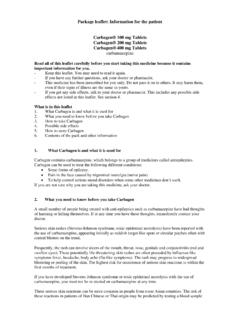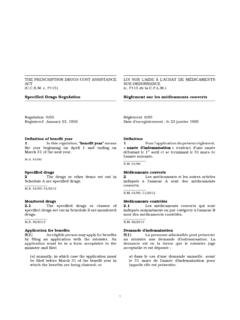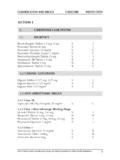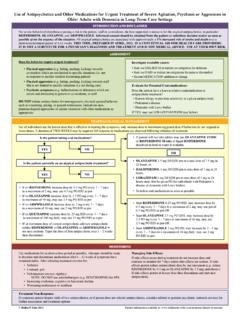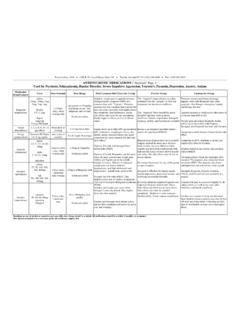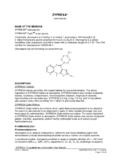Transcription of Name of Medicine - Medsafe
1 New Zealand Datasheet Name of Medicine olanzapine - drla film coated tablets olanzapine ODT- drla orodispersible tablets Presentation olanzapine - drla mg tablets are white, film coated, oval biconvex tablets debossed OLZ on one side and on the other. olanzapine - drla 5 mg tablets are white, film coated, oval biconvex tablets debossed OLZ on one side and 5 on the other. olanzapine - drla 10 mg tablets are white, film coated, oval biconvex tablets debossed OLZ on one side and 10 on the other. olanzapine ODT- drla orodispersible tablets are yellow coloured round shaped tablets convex on one side and flat on the other side. Do not halve the tablet. Dose equivalence when the tablet is divided has not been established. Uses Actions olanzapine is an atypical antipsychotic, antimanic and mood stabilising agent that demonstrates a broad pharmacological profile across a number of receptor systems.
2 In preclinical studies, olanzapine exhibited a range of receptor affinities (Ki; < 100 nmol) for serotonin 5HT2A/2C, 5HT3, 5HT6; dopamine D1, D2, D3, D4, D5; cholinergic muscarinic receptors m1 - m5; 1 adrenergic; and histamine H1 receptors. Animal behavioural studies with olanzapine indicated 5HT, dopamine and cholinergic antagonism, consistent with the receptor binding profile. olanzapine demonstrated a greater in-vitro affinity for serotonin 5HT2 than dopamine D2 receptors and in in-vivo models, greater 5HT2 than D2 activity. Electrophysiological studies demonstrated that olanzapine selectively reduced the firing of mesolimbic (A10) dopaminergic neurons, while having little effect on the striatal (A9) pathways involved in motor function.
3 olanzapine reduced a conditioned avoidance response, a test indicative of antipsychotic activity, at doses below those producing catalepsy, an effect indicative of motor side-effects. Unlike some other antipsychotic agents, olanzapine increased responding in an 'anxiolytic' test. In a single 10 mg oral dose Positron Emission Tomography (PET) study in healthy volunteers, olanzapine produced higher receptor occupancy at the 5HT2A receptor than at the dopamine D2 receptor. A Single Photon Emission Computed Tomography (SPECT) imaging study in schizophrenic patients revealed that olanzapine -responsive patients had lower striatal D2 occupancy than some other antipsychotic- and risperidone-responsive patients, while being comparable to clozapine-responsive patients.
4 In two of two placebo and two of three comparator controlled clinical trials with over 2,900 schizophrenic patients, with both positive and negative symptoms, olanzapine was associated with statistically significantly greater improvements in negative as well as positive symptoms of schizophrenia. Pharmacokinetics olanzapine is well absorbed after oral administration, reaching peak plasma concentrations within 5 to 8 hours. Absorption is not affected by food. Plasma concentrations of olanzapine after oral administration were linear and dose proportional in trials studying doses from 1 to 20 mg. olanzapine is metabolised in the liver by conjugative and oxidative pathways. The major circulating metabolite is the 10-N-glucuronide which does not pass the blood brain barrier.
5 Cytochromes P450-CYP1A2 and P450-CYP2D6 contribute to the formation of the N-desmethyl and 2-hydroxy-methyl metabolites, both exhibited significantly less in vivo pharmacological activity than olanzapine in animal studies. The predominant pharmacologic activity is from the parent olanzapine . After oral administration to healthy subjects, the mean terminal elimination half-life was 33 hours (21 to 54 hours for 5th to 95th percentile) and the mean olanzapine plasma clearance was 26 L/hr (12 to 47 L/hr for the 5th to 95th percentile). olanzapine pharmacokinetics varied on the basis of smoking status, gender and age. In healthy elderly ( 65 years) subjects versus non-elderly healthy subjects, the mean elimination half-life of olanzapine was prolonged ( hr vs hr) and the clearance was reduced ( L/hr vs L/hr).
6 The pharmacokinetic variability observed in elderly subjects is within the variability seen in non-elderly subjects. In 44 patients with schizophrenia > 65 years of age, dosing from 5 to 20 mg/day was not associated with any distinguishing profile of adverse events. In female versus male subjects, the mean elimination half-life was somewhat prolonged ( hr vs hr) and the clearance was reduced ( L/hr vs L/hr). However, olanzapine (5-20 mg) demonstrated a comparable safety profile in female (n =467) as in male patients (n = 869). Smoking induces the CYP1A2 metabolism of olanzapine . Therefore, in smokers the clearance of olanzapine is higher, on average, than the clearance in nonsmokers. The plasma clearance of olanzapine is lower in elderly versus non-elderly subjects and in females versus males.
7 The magnitude of the impact of age, gender or smoking on olanzapine clearance and half-life is small in comparison to the overall variability between individuals. The plasma protein binding of olanzapine is about 93% over the concentration range of about 7 to about 1000 ng/ml. olanzapine is bound to albumin and 1 acid glycoprotein. Approximately 57% of radiolabelled olanzapine is excreted in urine, principally as metabolites, approximately 7% is excreted unchanged in the urine after a single oral dose and approximately 30% is excreted in the faeces. Renal Impairment Only incomplete information is available on excretion in renal-impaired patients (creatinine clearance < 10 ml/min) versus healthy subjects, suggesting there was no significant difference in mean elimination half-life ( hr vs hr) or drug clearance ( L/hr vs L/hr).
8 The available data indicate a trend for decreased clearance and increased half-life with renal-impairment. Consequently, caution should be exercised in prescribing olanzapine for patients with renal impairment and particularly in those with severe renal disease and in the elderly. olanzapine is not removed by dialysis. The effect of renal impairment on metabolite elimination has not been studied. Hepatic Impairment Although the presence of hepatic impairment may be expected to reduce the clearance of olanzapine , a study of the effect of impaired liver function in male subjects (n=6) with clinically significant (Childs Pugh Classification A and B) cirrhosis revealed little effect on the pharmacokinetics of olanzapine in the dose range - mg daily. Consequently, dosage adjustment may not be necessary if hepatic impairment is the sole consideration.
9 Table 1: Mean and range of olanzapine pharmacokinetic variables for a single dose of olanzapine as 10 mg orally versus 10 mg intramuscularly administered as two 5 mg doses 4 hours apart. Pharmacokinetic Variable (units) Orally Administered olanzapine 10 mg Intramuscularly Administered olanzapine 2x5 mg 4 hrs Apart Mean (range) Mean (range) Cmax (ng/ml) ( to ) ( to )a AUC0- (hr) 499 (287 to 838) 522 (353 to 792) CLp (L/hr) ( to ) ( to ) t1/2 (hr) ( to ) ( to ) a The Cmax values in this table for olanzapine IM cannot be directly compared to those for the 10 mg oral dose. The IM dose was divided into two 5 mg doses 4 hours apart and the Cmax values generally reflect the second IM 5 mg dose. Indications olanzapine - drla tablets and olanzapine ODT- drla tablets are indicated in adults only for the treatment of schizophrenia and related psychoses.
10 olanzapine - drla tablets and olanzapine ODT- drla tablets are alone or in combination with lithium or valproate are indicated in adults only for the short-term treatment of acute manic episodes associated with Bipolar I Disorder. olanzapine - drla tablets and olanzapine ODT- drla tablets are indicated in adults only for preventing recurrence of manic, mixed or depressive episodes in Bipolar I Disorder. Dosage and Administration Schizophrenia and Related Disorders The recommended starting dose for olanzapine - drla tablets or olanzapine ODT- drla tablets is 5-10 mg/day, administered as a single daily dose without regard to meals. Daily dosage may subsequently be adjusted on the basis of individual clinical status within the range of 5 - 20 mg daily. An increase to a dose greater than the routine therapeutic dose of 10 mg/day is recommended only after appropriate clinical reassessment.











